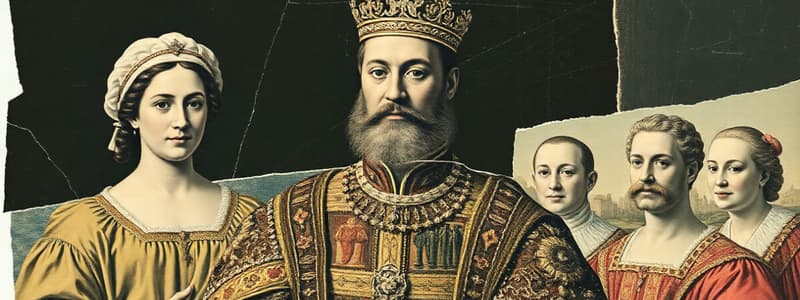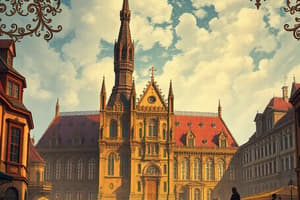Podcast
Questions and Answers
What was the main reason for the conflict between Parliament and the Stuart Kings?
What was the main reason for the conflict between Parliament and the Stuart Kings?
- The Stuart Kings refused to allow Parliament to tax the people.
- The Stuart Kings were Catholic, while Parliament was Protestant.
- The Stuart Kings sought to establish an absolute monarchy, while parliament wanted to maintain its power. (correct)
- The Stuart Kings wanted to abolish the Magna Carta.
What did the Bill of Rights guarantee?
What did the Bill of Rights guarantee?
- The right of citizens to freedom of speech and protection from excessive bail. (correct)
- The right of the King to tax the people without Parliament's consent.
- The right of the King to overturn Parliament's laws.
- The right of the King to use the army as a police force.
Which of the following actions did Queen Elizabeth I take to promote capitalism and mercantilism?
Which of the following actions did Queen Elizabeth I take to promote capitalism and mercantilism?
- She abolished tariffs on imported goods.
- She introduced a system of free trade.
- She encouraged overseas exploration and colonization by joint-stock companies. (correct)
- She supported the establishment of a national bank.
What was the outcome of the Glorious Revolution?
What was the outcome of the Glorious Revolution?
Why did Russia not fully industrialize by World War I?
Why did Russia not fully industrialize by World War I?
What type of monarchy did England have before Queen Elizabeth I?
What type of monarchy did England have before Queen Elizabeth I?
What was the significance of the Act of Uniformity?
What was the significance of the Act of Uniformity?
What major event took place in England during the Middle Ages that helped establish a limited monarchy?
What major event took place in England during the Middle Ages that helped establish a limited monarchy?
Which of the following was NOT a major issue Elizabeth I addressed during her reign?
Which of the following was NOT a major issue Elizabeth I addressed during her reign?
What was the primary reason for the execution of individuals during the reign of Queen Mary?
What was the primary reason for the execution of individuals during the reign of Queen Mary?
Which of the following is a true statement about Elizabeth I?
Which of the following is a true statement about Elizabeth I?
What was the name of the church that Elizabeth I established as the official religion of England?
What was the name of the church that Elizabeth I established as the official religion of England?
What was the significance of the Magna Carta in the context of England's political landscape?
What was the significance of the Magna Carta in the context of England's political landscape?
What was the main reason for the decline of the Catholic Church's power?
What was the main reason for the decline of the Catholic Church's power?
What event led to the decline of feudal lords and the rise of absolute monarchs?
What event led to the decline of feudal lords and the rise of absolute monarchs?
What is the definition of absolute monarchy?
What is the definition of absolute monarchy?
What is the idea of 'divine right' associated with absolute monarchy?
What is the idea of 'divine right' associated with absolute monarchy?
Which of the following monarchs is NOT considered an absolute monarch?
Which of the following monarchs is NOT considered an absolute monarch?
Which of the following best describes the economic policies used by Louis XIV?
Which of the following best describes the economic policies used by Louis XIV?
What negative consequence resulted from Louis XIV's reign?
What negative consequence resulted from Louis XIV's reign?
Which of the following best describes the state of Russia prior to Peter the Great's reign?
Which of the following best describes the state of Russia prior to Peter the Great's reign?
What was Peter the Great's goal in modernizing Russia?
What was Peter the Great's goal in modernizing Russia?
Which of the following is NOT a reform implemented by Peter the Great to Westernize Russia?
Which of the following is NOT a reform implemented by Peter the Great to Westernize Russia?
What impact did the lavish spending of absolute monarchs have on Europe?
What impact did the lavish spending of absolute monarchs have on Europe?
What were the French Protestants known as during the reign of King Henry IV?
What were the French Protestants known as during the reign of King Henry IV?
What did Louis XIV call himself?
What did Louis XIV call himself?
What was the name of the massive palace built by Louis XIV?
What was the name of the massive palace built by Louis XIV?
What was the name of the first czar of Russia?
What was the name of the first czar of Russia?
Why did Peter the Great travel around Europe in disguise?
Why did Peter the Great travel around Europe in disguise?
Flashcards
Peter the Great
Peter the Great
Czar of Russia who modernized the nation towards Western standards.
Limited monarchy
Limited monarchy
A form of government where the king's power is restricted by laws or a constitution.
Magna Carta
Magna Carta
Document signed in 1215 that limited the powers of the English king.
Parliament
Parliament
Signup and view all the flashcards
Elizabeth I
Elizabeth I
Signup and view all the flashcards
Protestant Reformation
Protestant Reformation
Signup and view all the flashcards
Bloody Mary
Bloody Mary
Signup and view all the flashcards
Religious conflict during Elizabeth's reign
Religious conflict during Elizabeth's reign
Signup and view all the flashcards
Absolute Monarchs
Absolute Monarchs
Signup and view all the flashcards
Divine Right
Divine Right
Signup and view all the flashcards
Decline of Feudalism
Decline of Feudalism
Signup and view all the flashcards
Louis XIV
Louis XIV
Signup and view all the flashcards
Power of the Catholic Church
Power of the Catholic Church
Signup and view all the flashcards
The Renaissance
The Renaissance
Signup and view all the flashcards
The Crusades
The Crusades
Signup and view all the flashcards
Edict of Nantes
Edict of Nantes
Signup and view all the flashcards
Versailles
Versailles
Signup and view all the flashcards
Mercantilism
Mercantilism
Signup and view all the flashcards
Hundred Years War
Hundred Years War
Signup and view all the flashcards
Longbow and Cannon
Longbow and Cannon
Signup and view all the flashcards
Maria Theresa
Maria Theresa
Signup and view all the flashcards
Absolute Monarchy
Absolute Monarchy
Signup and view all the flashcards
Act of Uniformity
Act of Uniformity
Signup and view all the flashcards
Elizabethan Golden Age
Elizabethan Golden Age
Signup and view all the flashcards
Stuart Monarchy
Stuart Monarchy
Signup and view all the flashcards
Glorious Revolution
Glorious Revolution
Signup and view all the flashcards
Bill of Rights
Bill of Rights
Signup and view all the flashcards
Study Notes
The Age of Absolute Monarchs
- By the end of the Renaissance, new nations formed.
- Many of these nations were ruled by powerful kings with unlimited power.
- The era from 1600 to the mid-1700s is known as the Age of Absolute Monarchs.
The Rise of Absolute Monarchs (Middle Ages)
- During the Middle Ages, European kings were not very powerful.
- Feudal lords held real power, controlling local manors and having loyalty of the people.
- The Catholic Church was the dominant religion and the Pope had power over the peasants.
The Rise of Absolute Monarchs (Factors Contributing)
- The Crusades stimulated trade and led to the rise of cities.
- The Renaissance and trade weakened the power of feudal lords.
- The Hundred Years' War involved new weapons. Longbows and cannons weakened the power of nobles and knights increased the power of kings.
- The power of the Catholic Church weakened after the Crusades and the Protestant Reformation.
- As the Church's power declined, the power of kings increased.
How Absolute Monarchs Worked
- During the Renaissance, European kings taxed merchants and bankers to increase their wealth for build centralized governments.
- Some monarchs used overseas exploration to gain colonies and increase their power.
Absolute Monarchy
- An absolute monarchy is a government where one king holds all the power within a nation.
- Absolute monarchs controlled all aspects of their nations (taxes, religion, military, economy).
- Absolute monarchs believed in divine right, the idea that God created the monarchy and kings answered only to God, not to the people.
Louis XIV of France
- France was in conflict between Catholics and French Protestants (Huguenots) before Louis XIV came to power.
- Louis XIV had a positive economic impact by encouraging manufacturing using overseas colonies and mercantilism to make France self-sufficient.
- Louis XIV had a negative impact due to expensive wars which failed to gain new lands.
- Louis XIV built the massive Palace of Versailles to glorify himself, using wealth and art.
Peter the Great of Russia
- Russia before Peter the Great was isolated from Western Europe and lagged in ideas and technology.
- Ivan III was the first czar. Russian czars expanded borders, gained power over nobles, established absolute monarchy.
- Peter the Great worked to modernize and westernize Russia, touring Europe in disguise to learn new ways.
- Peter the Great made several reforms after returning from Europe, including adopting European fashions, improving farming techniques, and establishing a modern army and factories.
The Legacy of Louis XIV
- Louis XIV's reign led to France becoming the most powerful nation but also left the nation with massive debts from lavish spending and heavy taxes.
- French people eventually grew frustrated and overthrew the monarchy.
The Legacy of Peter the Great
- Peter the Great resulted in Russia becoming a more advanced nation.
- Modernization was a slow process, and Russia did not fully industrialize until after World War I.
- Revolutions in World War I overthrew the monarchy and created a new government based on socialism.
Elizabeth I of England
- England's monarchs had limited power compared to other European nations.
- The Magna Carta, signed by King John in 1215, limited the king's power.
- Parliament is a legislative group, consisting of members of the commons and lords, who worked with the king. This resulted in limited monarchy in England.
- During her reign, Elizabeth worked with Parliament to settle important issues, especially issues of religion (Anglican or Catholic).
- The Act of Uniformity formalized English Protestantism.
- She supported capitalism and mercantilism using joint-stock companies to encourage trade.
- During her reign, England experienced a golden age of culture, especially literature and theater.
- Queen Elizabeth refused to share power with a male.
The Stuart Monarchy
- After Elizabeth's death in 1603, the Stuart family assumed the monarchy.
- The Stuart kings didn't work with Parliament and tried to create an absolute monarchy, which resulted in conflicts, a near civil war, and the Glorious Revolution.
The Bill of Rights
- After the Glorious Revolution, Parliament required the new monarchs to sign the Bill of Rights.
- The Bill of Rights protected citizens from their government.
- The King couldn't tax or overturn Parliament's laws.
- Freedom of speech was protected.
- The Army could not be used by the government without an act of Parliament.
- The Magna Carta, along with the Bill of Rights, created a constitutional monarchy in England.
Studying That Suits You
Use AI to generate personalized quizzes and flashcards to suit your learning preferences.



